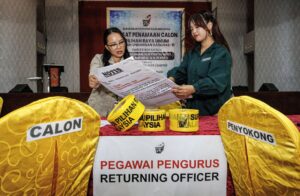
China put its growing deterrence power on show in Beijing on Wednesday with a slew of new nuclear missiles for the People’s Liberation Army (PLA), many of which could reach the United States.
Among the weapons appearing in public for the first time was the Jing Lei-1, or JL-1, long-range air-launched ballistic missile (ALBM).
ALBMs are typically launched from bombers and are considered to be a pillar of a nuclear triad – a three-pronged military force structure for delivering nuclear weapons alongside intercontinental ballistic missiles (ICBMs) and submarine-launched ballistic missiles (SLBMs).
The missile is China‘s first known ALBM and possibly could be launched from an H-6 bomber, completing Beijing’s nuclear triad.
Another key debut in the military parade in Beijing was that of the JL-3, a third-generation intercontinental-range SLBM that is considered a cornerstone of China‘s sea-based nuclear deterrent. It is designed to be carried by the Type 094 and potentially future Type 096 nuclear submarines.
With a reported operational range of over 10,000km (6,200 miles), the JL-3 can carry three multiple independently targetable re-entry vehicles (MIRVs) and has the capacity to reach the US mainland.
“I believe the JL-3 submarine-launched ICBM is something new – it should be the ICBM with the longest range launched from under the sea,” retired senior colonel Zhou Bo told state broadcaster CGTN. “So that is really something impressive.”
Timothy Heath, a senior international defence researcher at the US-based Rand Corporation, said the ALBM and improved SLBM provided China a “true nuclear triad capability.”
“Previously, China’s SLBM did not have an ICBM range, and the PLA lacked an air-launched nuclear strike option. This has now been corrected. China has a robust nuclear second-strike capability that will be extremely difficult to disarm with a first strike by any adversary,” Heath said.
The military parade also displayed China’s latest ICBM models, including the DF-61, the DF-31BJ and the DF-5C – all of which are believed to be able to reach the continental US.
While there were no previous reports or publicly available information, the DF-61 is thought to be a successor and an upgrade of the DF-41, possibly exceeding the range of 12,000-15,000km.
The DF-31BJ is thought to be a silo-based upgrade of the DF-31 solid-fuelled ICBMs, and its appearance in the parade signals that the PLA Rocket Force has already begun the upgrade of the DF-31 variants.
China also unveiled the DF-5C, a previously unknown upgraded variant of China’s first ICBM, the silo-based DF-5 series. It has a range of more than 13,000km, and can carry up to 10 MIRVs. State broadcaster CCTV said the missile could “cover the entire globe”.
Chinese aviation analyst Fu Qianshao said China was one of only a handful of countries that had ICBMs and its stockpile had improved in operational ability and range.
“The improved variant of the DF-31 [in the parade], which has intercontinental range, could serve as our strategic pillars,” Fu said.
“Any country considering a nuclear attack against China must carefully weigh the consequences, as we possess multiple means of retaliation.”
Former PLA instructor Song Zhongping said the array of missiles on show “demonstrated China’s ability to conduct nuclear strikes across all three domains – sea, land and air – significantly enhancing its nuclear capabilities”.
“This is particularly true in terms of nuclear counter-attacks, as China’s nuclear strategy has not changed and remains focused on active defence,” Song said, adding that the country’s nuclear strength, especially the DF-5C, was “designed to target hostile nuclear powers”.
“This move is intended to deter and block interference from non-regional countries in China’s internal affairs, particularly in the Taiwan and South China Sea issues.”
Beijing sees Taiwan as part of China to be reunited by force if necessary. Most countries, including the United States, do not recognise Taiwan as an independent state, but Washington is opposed to any attempt to take the self-governed island by force and is committed to supplying it with weapons.
Shi Yinhong, professor of international relations at Renmin University, said China had improved in missiles in “absolute terms”, especially in medium- and long-range cruise missiles and hypersonic weapons.
However, he also said that “relative to the advances in the quality and quantity of US and allied armaments, the gap may not have narrowed much”.
Yoon Suk-joon, a senior fellow at the Korea Institute for Military Affairs in Seoul and a specialist in Chinese weapons systems, said China’s new nuclear deterrence had not yet reached that of the US or Russia, with MIRV performance in the terminal phase a key metric.
He added that China may shift to uncrewed technology for its nuclear deterrence in the coming years.
“It looks like they are … developing the CH-7 drones as a means of delivering nuclear warheads. So, even though [the nuclear missiles at the military parade] are new, it doesn’t pose much of a threat other than its operational range,” said Yoon, a retired South Korean navy captain.
Outside observers have noted the PLA’s rapidly expanding nuclear forces.
According to a report in June by the Stockholm International Peace Research Institute, a Swedish think tank, China had 600 warheads as of January, after adding 100 more to its nuclear stockpile since 2023.
While China’s nuclear force was far less than that of the US or Russia – which had 5,177 and 5,459 warheads respectively – it had the “fastest-growing nuclear arsenal in the world”, the report said.
The Pentagon estimates that China will have more than 1,000 operational nuclear warheads by 2030, most of which will be fielded on systems capable of reaching the continental US.
In a report in December, it said China had an estimated 400 ICBMs as of 2023, and had “probably completed” construction of three solid-propellant silo fields as of 2022.
China’s new ICBMs would “significantly improve” its nuclear-capable missile forces and require increased nuclear warhead production, the report said.
The US has been trying to include China in the discussion for a nuclear arms control treaty, but the Chinese foreign ministry has said it is “neither reasonable nor realistic” for Beijing to take part.
Song said that while Beijing’s nuclear arsenal might appear formidable, its numbers were significantly lower than those of the US and Russia, and it was not willing to join a treaty – at least not yet.
“Beijing may hope that the first-tier countries will reduce their nuclear weapons first, and when they have reduced their nuclear weapons to a certain extent, Beijing will follow suit,” Song said. “Therefore, Beijing will not participate in such negotiations now.”
Heath said China sought to build up its nuclear arsenal to a “number that is closer to the arsenals of the United States and Russia”.
“Thus, China does not want to discuss arms limitations as it feels agreeing to such limits would put China at a disadvantage,” he said. – SOUTH CHINA MORNING POST






